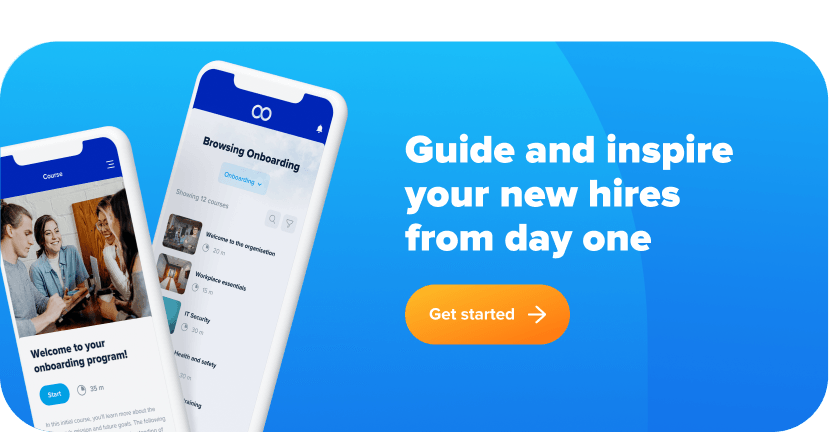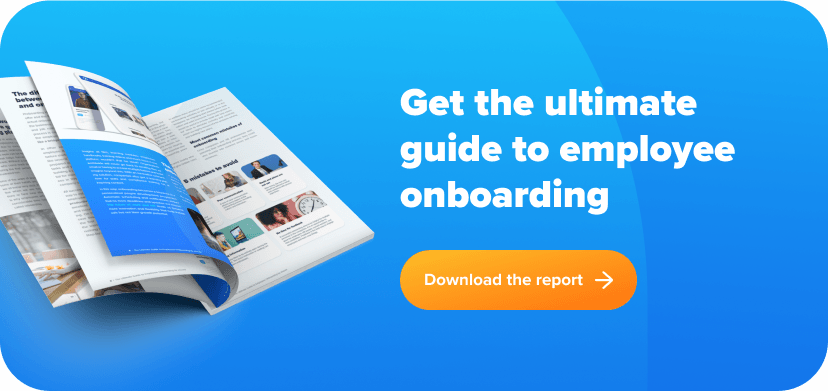What is reboarding
Reboarding is a concept that specifies a different type of onboarding process. It is meant to recreate old connections between former colleagues or employees who have been absent for a while.
By bringing employees and managers up to date, reboarding also re-establishes a stronger relationship between the individual employee and the organization and adjusts individual and teamwork routines to a new reality, for example, post-pandemic or after a long illness or maternity or paternity leave.
When individuals are back to work, they require a structured roadmap to get the necessary updates and a proper ‘welcome back’ atmosphere.
The reboarding process differs from the onboarding because it’s about current or former employees.
While new hires are joining a company for the first time, some employees may re-join after a long absence.
Both need a plan to be effective and align with the job responsibilities and the organization and business vision. In addition, a reboarding plan should support the adoption of new ways of working or routines and refresh or learn new skills.

Back to business
The latest pandemic has forced many employees worldwide to work remotely for an extended period of time. Not just employees but new hires jumped into a new role with a fresh start from their homes.
As we all know, extraordinary times call for extraordinary measures.
The future of work will be characterised by greater flexibility, asynchronous learning and communication, and home offices, resulting in the so-called hybrid work.
Coming back to work can give us conflictual feelings. After months of adapting to remote work and finding best practices to balance our professional and private lives, it can be tough to get back.
In addition, there are essential measures to incorporate when we share our space with other people. It’s crucial to maintain a high level of engagement, productivity and wellbeing too.
That’s why companies and HR departments need to figure out the best process for reboarding employees effectively.

Better be safe
Now that we’ve talked about why a good reboarding practice can solve some HR challenges, let’s look at what you can actually do.
What matters the most is safety and security. This should be done following the governmental guidelines concerning the hygiene and required procedures to ensure a safe working environment for all.
Secondly, it’s crucial to recall compliance in advance. Your employees can have a fresh recap using a smart and intuitive LMS. Microlearning and gamified courses are the quickest and most effective ways to ensure compliance in your organisation.
Make a basic plan or guidebook for reboarding that includes a short checklist of the essential cybersecurity issues and best practices to avoid any online threats. Both new hires and current employees will appreciate reminders of their digital office routines to save time as well.

Back on track with a great reboarding plan
Reboarding employees after a long period of absence for various reasons (maternity, sickness, work leave) requires an effective plan and proper guidance. To clarify the matter, reboarding is not a second onboarding, but it represents a second great opportunity to ensure that former employees are engaged and aligned with the company vision.
People are not starting from scratch, but they may have questions and a great need to recap the latest happenings in their teams.
Moreover, some colleagues may be ready for a full re-socialization, but others may appreciate a gradual return to spend their workdays in the company of their peers.
Some employees may feel like ‘new hires’ even if they have worked in a company for a long time. This is the result of a long absence and missing updates. That’s why reboarding can help the whole corpotation have a practical and inclusive approach when having people back at work. The transition can be easily managed with a clear structure to follow to avoid gaps and ambivalent behaviour.
If you expect your former employees to be ready from the returning day, the reboarding process needs a clear structure with steps and recap training for compliance and IT.
4 essential actions to reboard colleagues
- Communicate – enable a transparent dialogue but don’t overwhelm your people
- Include – offer time to settle back and incorporate (again) the company culture
- Listen – your employees need to be heard. They may have doubts or new needs
- Inform – make an accessible plan to provide all the updates and latest news
When a company provides a reboarding strategy it is crucial to maintain a flexible work style. So, employees can work with stronger engagement and productivity while balancing their wellbeing.
Following practical tips and implementing best practices will help you prioritize what matters the most and focus on employees’ mental health. Some people could potentially be back from a long sick leave or family reasons, so empathy and other soft skills can make the difference in handling sensitive conversation or making employees comfortable at work.
During the planning of reboarding, it’s important to take into consideration the necessary skills that managers need to better support the workforce during this phase. With an e-learning and management platform like eloomi, you can create ad hoc courses specifically for reboarding purposes or find the right training inside our content library.

Takeaways to start reboarding your workforce effectively
Companies must foresee their employees’ needs and expectations once they are returning to work. Reboarding doesn’t concern only safety measures for blue-collar workers, but it entails a whole method of starting over for all kinds of hires. It’s both a sensitive and pivotal moment.
A common mistake is assuming that former employees come back to work with the same attitude as new hires. They may ‘feel’ like new hires but in a less exciting and more concerning way. For instance, your furlough employees could lack confidence or feel apprehensive when it comes to rules or compliance. Thus, you should create a safe space to engage and welcome people who are re-joining their jobs.
In addition, the reboarding process can be helpful to employees who are changing roles or departments within the same organization. It’s a unique chance for leaders to reinforce the vision and strategy while caring for their people’s wellbeing and performance.







